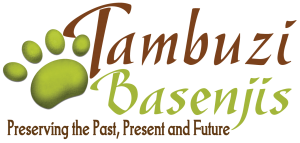What are the signs of a Cerebrovascular Accident?
What are the signs of a Cerebrovascular Accident? (CVA). They are very much like strokes. Signs of strokes in dogs are different to the signs in humans. In humans a drooping face or partial paralysis of one side of the body are common signs. Such signs are rarely associated with strokes in dogs.
In the case of a CVA the dog generally appears mildly drunk and uncoordinated. They may circle and fall down. In Basenjis these symptoms seem to me much worse than with other breeds. They might look severely drunk, like a new born Bambi with a head injury. They are prone to knuckle over and fall down regularly. As Dr Aine Seavers writes ' they truly look horrendous'. Dr Seavers is concerned that Basenjis showing these signs may be put to sleep, when normally even the most horrendous cases will fully recover given the right medication and time.
The other thing to note is that unlike other breeds, elderly Basenjis can have more than one episode. The CVA's usually occur either around Easter as they strut their old bodies like they are 2 years old. They are not 2 years old, so they have an episode or if the weather suddenly turns cold or there is an extended cold period. They recover and the newer medications we have make them more comfortable and appear to return to normal faster as well. Unlike with a stoke a second episode doesn't mean anything. Often a dog will go many months to several years without further episode. If however if you get multiple episodes in a short space of time then that case needs to be looked at differently.
I think my dog has had a Cerebrovascular Accident what do I do?
I think my dog has had a Cerebrovascular Accident (CVA) what can I do?
Firstly take your dogs to your vet. Once diagnosed your vet will give you some medication. Be sure to advise your vet that Basenjis often look really bad when having a CVA but given the correct medication they normally recover very well.
In addition to the medications prescribed by your vet there are a few other things that you can do to assist your dogs speedy recovery:
- Place the dog in a room with a comfortable temperature, i.e. not too hot or too cold;
- Crate the dog if possible so the dog can't do more damage by wandering off when so dizzy;
-
Keep lights dim and minimal stimulation re noise etc.;
-
Avoid extremes of temperature;
-
Syringe teaspoons of water into mouth every 2-3 hrs first day – don't worry too much about them eating for the first 24-48hrs but on the second day you can try them with food;
-
Avoid any fatty or high meat diet meals for a while; and
-
Vegies and some boiled chicken or white fish usually the second day. Serve in small balls handed to the dog for a few days as eyes moving so fast and the dog so dizzy that they can't work out how to get the head in the bowl and pick up the food.
Note: it can take 4 days for a dog to begin to improve. They are normally back to normal by about day 10.

